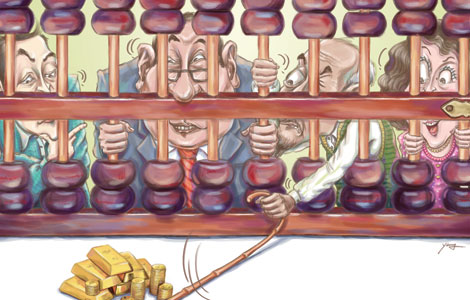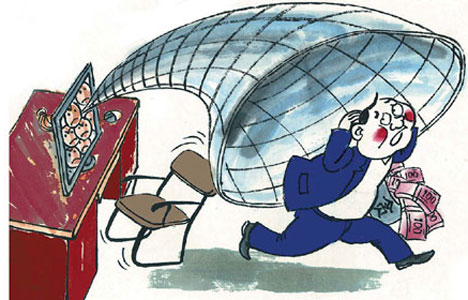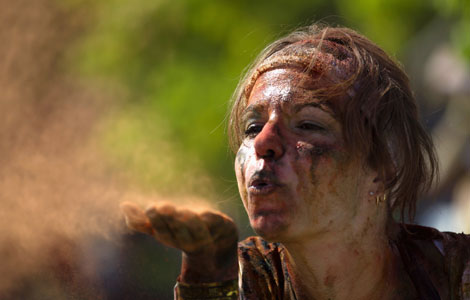Grim fight on drug smuggling for nation
Updated: 2013-05-21 01:15
By ZHANG YAN (China Daily)
|
|||||||||||
Drugs smuggled from abroad, including Southeast Asia and some Central and South Asian countries, are the main sources of underground drug use across China, according to a senior anti-drug official from the Ministry of Public Security.
"Despite great efforts in combating cross-border drug trafficking, we're still facing a grim situation in the fight against drugs from abroad," Liu Yuejin, director of the ministry's narcotics department, said in an exclusive interview.
Figures from the ministry show more than 90 percent of heroin and methamphetamine tablets available through China's black market come from Southeast Asia.
Last year, police in Yunnan province seized 5.37 metric tons of heroin - 73 percent of the total nationwide - and 8.95 tons of methamphetamine (55 percent of the nationwide total), smuggled over the border with Myanmar.
Cases of drug smuggling have also risen sharply on the border between China and Vietnam.
Authorities in the Guangxi Zhuang autonomous region uncovered 3,224 cases last year, seizing 415 kg of heroin, up 100 percent from 2011.
Liu said China borders two major sources of drugs - the Golden Triangle (comprising parts of Thailand, Laos and Myanmar) and the Golden Crescent, made up of parts of Central and South Asia.
Opium poppy planting in the Golden Triangle covered about 40,000 hectares last year, producing more than 60 tons of heroin, according to the ministry.
Liu said there has been rampant smuggling of synthetic drugs in China from Southeast Asia, including Myanmar, northern Laos and Vietnam, through border areas between Yunnan and Guangxi.
Poppy planting in Afghanistan, Pakistan and Iran has reached a total of 154,000 hectares, which can produce more than 370 tons of heroin.
"A large quantity of heroin produced in these areas is usually smuggled to the Xinjiang Uygur autonomous region, and transferred to Southeast Asian countries, such as Malaysia and Vietnam, and then into Guangdong province by plane ," Liu said.
Drugs: Cross-border judicial communication needed
Recently, drug traffickers have tried to use shipments of marble, carpets and even Buddha statuettes to transport drugs as well as more traditional methods, such as the human body, bags or cars, said Yang Zhaohui, another senior official with the ministry's narcotics department.
"Suspects tend to become violent, and even use weapons to fight us at checkpoints," Yang said.
Cross-border traffickers often use high-tech methods, including wiretapping and network controlling, in remote areas to counter police investigations and avoid punishment, Yang said.
"Gang members form a strict management, and assume different tasks, including arranging drug sources, hiring traffickers, modifying vehicles, transport and sales," he said.
To tackle the problem, China has established judicial cooperation with Southeast Asian countries, including Myanmar, Laos, Thailand and Malaysia, Liu said. He added that China is promoting law enforcement cooperation with some countries in Central and South Asia, including Pakistan and Afghanistan.
China is also trying to deepen judicial cooperation with North American and European countries to strengthen intelligence exchanges and case cooperation, Liu said.
Hong Daode, a law professor from China University of Political Science and Law, said: "The priority is to get the clues and relevant intelligence information for drug trafficking crimes."
Liu said the authorities face challenges in combating cross-border drug trafficking, as it is difficult to uncover trafficking networks and capture gang leaders, as well as conducting investigations and collecting evidence.
"We need to cooperate with judicial authorities in other countries to identify foreign suspects, and liaise on evidence-collecting abroad," he said.
Related Stories
Official to discuss anti-drug smuggling in NZ 2012-10-15 14:30
Taiwan cracks cross-Straits drug smuggling case 2012-09-15 19:13
More women aid drug-smuggling boyfriends 2012-08-13 23:55
Anti-drug smuggling unit on form on Jilin border 2011-05-31 16:06
Philippine gov't urges crackdown on drug smuggling 2011-04-01 17:05
Drug trafficking post on rise 2013-03-14 21:47
Today's Top News
China, India can build trust: Premier Li
First-tier cities barely livable, report says
Massive blast claims 13 in Shandong
Fight on drug smuggling for nation
China most financially secure country
Tajikistan president visits China
Voyage to Mars has its skeptics
Premier visits Gandhi's tomb
Hot Topics
Lunar probe , China growth forecasts, Emission rules get tougher, China seen through 'colored lens', International board,
Editor's Picks

|

|

|

|

|

|





